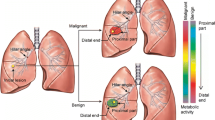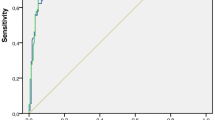Abstract
Purpose
The aim of the study was to determine an optimal method for the evaluation of scintigrams obtained with 99mTc-EDDA/HYNIC-TOC for the purpose of differential diagnosis of solitary pulmonary nodules (SPNs) and to assess the diagnostic value of the method.
Methods
Eighty-five patients (48 males and 37 females, mean age 57 years, range 34–78 years) were enrolled in the study. Patients underwent 99mTc-EDDA/HYNIC-TOC scintigraphy for the purpose of differential diagnosis of SPNs (size between 1 and 4 cm). Images of all patients were evaluated visually in a prospective manner.
Results
Positive scintigraphic results were found in 37 out of 40 (93%) patients with malignant SPNs including 34 out of 35 (97%) patients with primary lung carcinoma. Two remaining false negative cases turned out to be metastatic lesions of malignant melanoma and leiomyosarcoma. Among 45 benign tumours, negative results were obtained in 31 cases (69%) and positive results in 14. The accuracy of the method was 80%. Analysis of the results of the visual assessment of scintigrams revealed a significantly higher frequency of false positive results among larger nodules (diameter at least 1.4 cm). Uptake of the tracer in those nodules was therefore assessed semi-quantitatively (using the tumour-to-background ratio), in expectation of an improvement in the low specificity of the visual method. The semi-quantitative assessment reduced the total number of false positive results in a subgroup of larger nodules from 13 to six, while preserving the high sensitivity of the method.
Conclusion
The combination of visual analysis (for lesions smaller than 1.4 cm in diameter) and semi-quantitative assessment (for larger lesions) provided a high sensitivity of the method and significantly improved its specificity (84%) and accuracy (88%) in comparison with visual analysis (p<0.05).




Similar content being viewed by others
References
Ost D, Fein AM, Feinsilver SH. The solitary pulmonary nodule. N Engl J Med 2003;348:2535–42
Hanley KS, Rubin JB. Classifying solitary pulmonary nodules. New imaging methods to distinguish malignant, benign lesions. Postgrad Med 2003;114(2):29
Gould MK, Maclean CC, Kuschner WG, Rydzak CE, Owens DK. Accuracy of positron emission tomography for diagnosis of pulmonary nodules and mass lesions: a meta analysis. JAMA 2001;285:914–24
Gambhir SS, Shepherd JE, Shah BD, Hart E, Hah CK, Valk PE, et al. Analytical decision model for the cost-effective management of solitary pulmonary nodules. J Clin Oncol 1998;16(6):2113–25
Dietlein M, Weber K, Afschin G, Moka D, Theissen P, Lauterbach KW, et al. Cost-effectiveness of FDG-PET for the management of solitary pulmonary nodules: a decision analysis based on cost reimbursement in Germany. Eur J Nucl Med 2000;27:1441–56
Bedford M, Maisey MN. Requirements for clinical PET: comparison within Europe. Eur J Nucl Med Mol Imaging 2004;31:208–21
Blum J, Handmaker H, Lister-James J. A multicenter trial with a somatostatin analog 99mTc depreotide in the evaluation of solitary pulmonary nodules. Chest 2000;117:1232–8
Kahn D, Menda Y, Kernstine K, Bushnell D, McLaughlin K, Miller S, et al. The utility of 99mTc depreotide compared with F-18 fluorodeoxyglucose positron emission tomography and surgical staging in patients with suspected non-small cell lung cancer. Chest 2004;125:494–501
Sreedharan SP, Kodama KT, Peterson KE. Distinct subsets of somatostatin receptors in cultured human lymphocytes. J Biol Chem 1989;264:949–53
Płachcińska A, Mikołajczak R, Maecke HR, Michalski A, Rzeszutek K, Kozak J, et al. 99mTc-EDDA/HYNIC TOC scintigraphy in differential diagnosis of solitary pulmonary nodules. Eur J Nucl Med Mol Imaging 2004;31:1005–10
Sortini A, Carcoforo P, Simona A, Sortini D, Pozza E. Significance of a single pulmonary nodule in patients with previous history of malignancy. Eur J Cardiothorac Surg 2001;20:1101
Kernstine KH, Kahn D, Menda Y. A new technique for staging potentially resectable lung cancer: NeoTec SPECT Tc-99m (NeoTec) compared with F-18 FDG. American Society of Clinical Program/Proceedings 2001;20:339a
Zucker RJ, Bradley YC. Is semi-quantitative NeoTect® scintigraphy the new gold standard for solitary pulmonary nodules? J Nucl Med 2002;228(suppl II):564
Płachcińska A, Mikołajczak R, Kozak J, Rzeszutek K, Kuśmierek J. Comparative analysis of 99mTc-depreotide and 99mTc-EDDA/HYNIC-TOC thorax scintigrams acquired for the purpose of differential diagnosis of solitary pulmonary nodules. Nucl Med Review Cent East Eur 2006; to be published
Virgolini I, Leimer M, Handmaker H, Lastoria S, Bischof C, Muto P, et al. Somatostatin receptor subtype specificity and in vivo binding of a novel tracer, 99mTc-P829. Cancer Res 1998;58:1850–9
Freeman LM, Blaufox MD. Letter from the editors. Semin Nucl Med 2002;32(2):77
Goldsmith SJ. Guest editorial. Semin Nucl Med 2002;32(2):78
Płachcińska A, Mikołajczak R, Maecke H, Młodkowska E, Kunert-Radek J, Michalski A, et al. Clinical usefulness of 99mTc-EDDA/HYNIC-TOC scintigraphy in oncological diagnostics: a pilot study. Cancer Biother Radiopharm 2004;19(2);261–70
Reubi JC, Schar JC, Waser B, Wenger S, Heppeler A, Schmitt JS, et al. Affinity profiles for human somatostatin receptor subtypes SST1–SST5 of somatostatin tracers selected for scintigraphic and radiotherapeutic use. Eur J Nucl Med 2000;27:273–82
Płachcińska A, Mikołajczak R, Kozak J, Rzeszutek K, Kuśmierek J. A visual and semi-quantitative assessment of 99mTc-EDDA/HYNIC-TOC scintigraphy in differentiation of solitary pumonary nodules. Nucl Med Review Cent East Eur 2004;7(2):143–50
Płachcińska A, Mikołajczak R, Kozak J, Rzeszutek K, Kuśmierek J. Semiquantitative assessment of 99mTc-EDDA/HYNIC-TOC scintigraphy in differentiation of solitary puomonary nodules—a complementary role to visual analysis. Cancer Biother Radiopharm 2006;21(1):61–7
Vesselle H, Schmidt RA, Pugsley JM, Li M, Kohlmyer SG, Vallires E, et al. Lung cancer proliferation correlates with [F-18]fluordeoxyglucose uptake by positron emission tomography. Clin Cancer Res 2000;6(10):3837–44
Dimitrakopoulou-Strauss A, Georgoulias V, Herth F, Koukouraki S, Maecke H, Haberkorn U, et al. Quantitative assessment of SSTR 2 expression in patients with non-small-cell-lung-cancer using Ga-68-DOTATOC PET and comparison to F-18-FDG. Eur J Nucl Med Mol Imaging 2006; to be published
Reubi JC, Krenning E, Lamberts SW, Kvols L. In vitro detection of somatostatin receptors in human tumors. Metabolism 1992;41(9 suppl2):104–10
Kwekkeboom DJ, Krenning EP. Somatostatin receptor imaging. Semin Nucl Med 2002;32(2):84–91
Reubi JC, Horisberger U, Laissue J. High density of somatostatin receptors in veins surrounding human cancer tissue: role in tumor-host interaction? Int J Cancer 1994;56(5):681–8
Author information
Authors and Affiliations
Corresponding author
Rights and permissions
About this article
Cite this article
Płachcińska, A., Mikołajczak, R., Kozak, J. et al. Differential diagnosis of solitary pulmonary nodules based on 99mTc-EDDA/HYNIC-TOC scintigraphy: the effect of tumour size on the optimal method of image assessment. Eur J Nucl Med Mol Imaging 33, 1041–1047 (2006). https://doi.org/10.1007/s00259-006-0117-3
Received:
Accepted:
Published:
Issue Date:
DOI: https://doi.org/10.1007/s00259-006-0117-3




